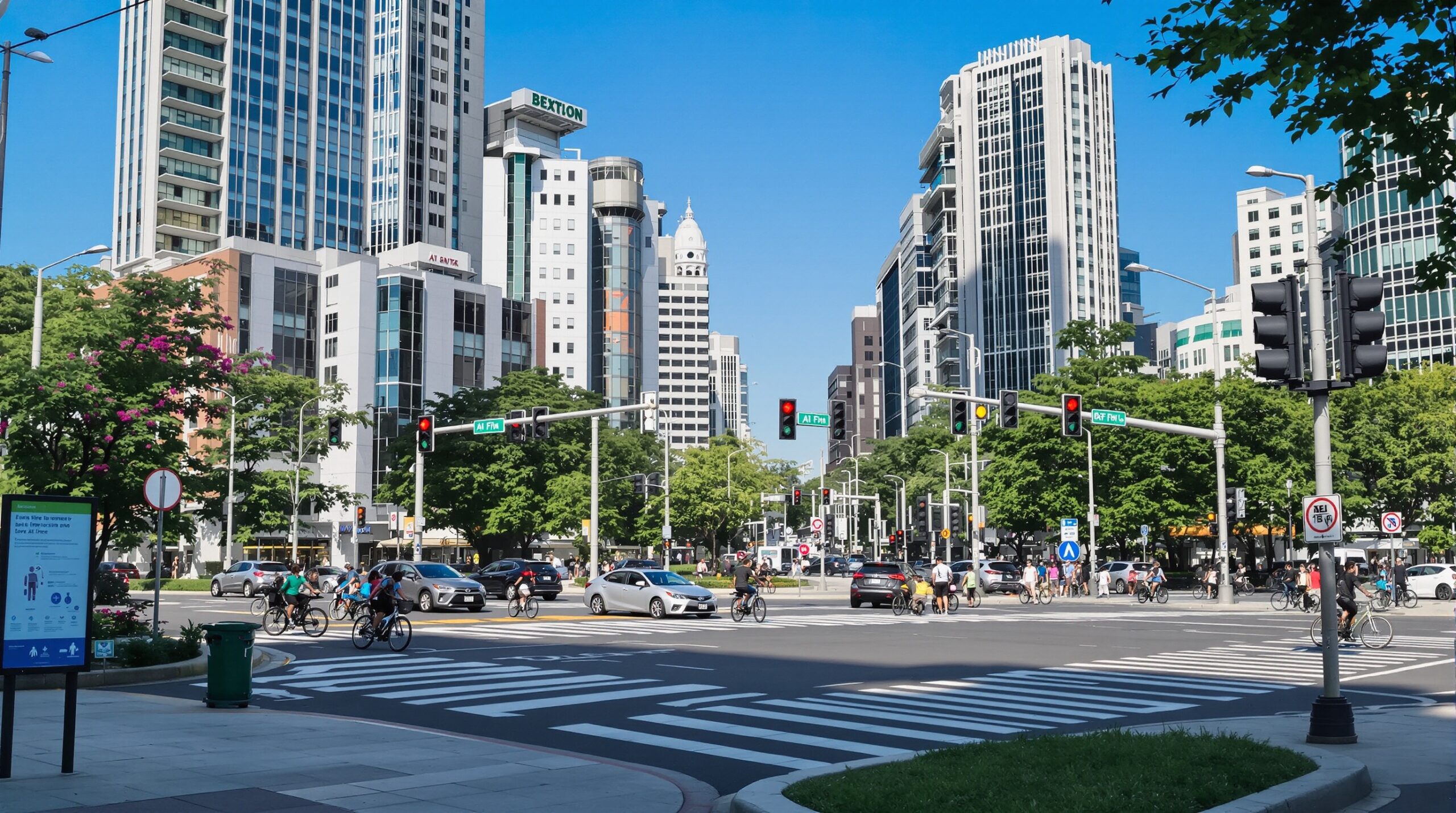Urban areas are growing at a rapid pace, bringing more vehicles to city streets. This escalation strains traffic systems and increases pollution. Traditional traffic signals use pre-set cycles and lack real-time adaptability. As a result, congestion and emissions often rise during peak hours. City planners are now turning to Artificial Intelligence (AI) for smarter solutions.
How AI-Driven Traffic Signals Work
AI-driven traffic signals use sensors, cameras, and cloud computing to monitor traffic flow in real-time. The system collects data such as vehicle counts, speeds, and congestion points. Machine learning algorithms process this information instantly. Smart signals can then change red or green lights based on actual demand, rather than fixed timers. This flexibility helps prevent long lines and wasted idling.
Smart signals communicate with each other throughout a city grid. When a street sees rising congestion, nearby signals coordinate to clear cars more efficiently. This networked approach offers significant improvements over isolated, outdated systems. Drivers spend less time stopped at lights, resulting in smoother commutes. This important change also reduces vehicle emissions, which drop when engines run less while idling.
Cities Taking the Lead in AI Traffic Management
Several major cities serve as pioneers for AI-driven signal pilot programs. Pittsburgh, Pennsylvania, tested an adaptive traffic control system called Surtrac. This system reduced travel times by up to 25% on some corridors. Cambridge, Massachusetts, also adopted smart signals along major bus routes. These signals helped increase bus reliability while reducing overall wait times.
Across the globe, Singapore’s Land Transport Authority rolled out AI signals at busy intersections. Early results indicated a drop in stop-and-go traffic by up to 15%, coupled with lower emissions. Los Angeles and Phoenix have begun integrating AI into their broader smart city plans. Urban planners choose these systems to address both daily congestion and long-term sustainability goals. Each project collects valuable data for refining and expanding the technology.
Impact on Congestion and Emissions
Traffic congestion causes frustration, lost time, and higher costs for residents. AI-driven signals help keep traffic moving, significantly reducing delays. This reduction means fewer minutes stuck in traffic, saving fuel for both individual drivers and commercial fleets. Multiple pilot studies have shown travel times drop between 10% and 25% after installing smart signals. Some cities even report accident rates falling, due to smoother flows and fewer abrupt stops.
Emissions from idling vehicles contribute to urban air pollution and climate change. By cutting down on idle times, cities with AI traffic management record measurable improvements in air quality. Reports from Pittsburgh and Singapore noted decreases in both nitrogen oxide and carbon dioxide. Cleaner air supports public health and aids cities in achieving tougher climate targets. Such outcomes also encourage residents and city officials to support further smart infrastructure upgrades.
Challenges with AI Traffic Signals Implementation
Rolling out AI-enabled traffic signals is not without hurdles. Older cities often have legacy infrastructure that requires costly upgrades before modernization. Integrating sensors, cameras, and new software involves both financial and technical investments. Municipal budgets are sometimes limited, making it hard to fund large-scale deployments. Data privacy is another common concern, as AI systems gather real-time information from public streets.
Cybersecurity threats also demand attention. As traffic systems grow more connected, risks of hacking or technology failures increase. Experts urge proper safeguards such as network encryption and strict access controls. Careful planning ensures safety and helps prevent new points of vulnerability. Despite these challenges, many city officials consider the benefits worth the upfront efforts. Early successes inspire additional investment and innovation in urban mobility.
Integration with Other Urban Mobility Solutions
AI-based traffic signals complement broader smart city goals. Many systems now integrate with public transit schedules and bike lanes. For example, adaptive signals can prioritize buses or trams as they approach intersections. This strategy supports more reliable mass transit, which in turn encourages fewer car trips. Some cities even send real-time traffic light changes to navigation apps, allowing drivers to adjust routes and avoid congestion.
Industry leaders see AI as the backbone for future innovations. Upcoming advances may allow direct coordination with connected and autonomous vehicles. These vehicles will relay their expected routes and timings to traffic control systems, enabling even smarter signal changes. Such integration lays the groundwork for fully automated, low-emission city streets. Forward-looking urban planners are preparing for continued evolution with scalable, flexible technologies.
Community Engagement and Equity Considerations
Transparency and equity play crucial roles in successful AI traffic deployments. Residents and local officials must understand how and why new systems are chosen. Community meetings and online dashboards allow for feedback, performance tracking, and open communication. Inclusive planning ensures all neighborhoods benefit, not just those with higher traffic volumes or commercial activity.
Some cities focus upgrades on busier corridors, but advocates call for expanding benefits to underserved areas. Equitable access is essential, especially in communities facing disproportionate air quality problems. Data-driven approaches can also highlight improvement needs beyond downtown districts. Community engagement fosters trust, helping smart technology reach its full potential for everyone.
Future Outlook for AI-Driven Traffic Signals
Momentum behind AI-driven traffic management continues to build. As early projects deliver positive results, more cities look to adopt and scale the technology. AI innovation may soon enable faster, more detailed adaptation to shifting traffic patterns. Integration with real-time weather data, ride-hailing apps, and event schedules promises even greater efficiency boosts.
Transportation researchers explore new algorithm designs that learn city-specific challenges. Investments from government and private-sector partners support robust pilot programs worldwide. Urban residents increasingly demand smarter and cleaner solutions to daily transportation problems. The path forward blends technology, policy, and public engagement, offering a new model for modern city life.
Conclusion
AI-driven traffic signals mark a major step in reshaping urban mobility and public health. Leaders in both government and technology champion adaptable systems that ease congestion and lower emissions. While challenges exist, early successes suggest substantial long-term benefits for cities, commuters, and the environment. As more cities test and refine these systems, smarter streets may soon become a hallmark of sustainable urban living.

